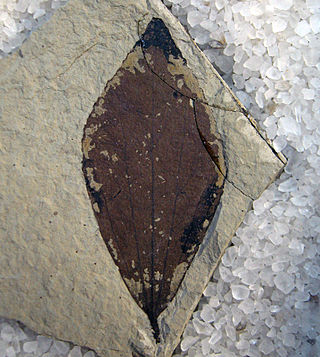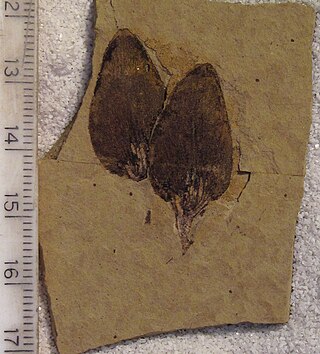Ulteramus is an extinct genus of parasitic wasp in the sawfly family Pamphiliidae. The genus is solely known from an Eocene fossil found in North America. At the time of its description the new genus was composed of a single species, Ulteramus republicensis.

Tilia johnsoni is an extinct species of flowering plant in the family Malvaceae that, as a member of the genus Tilia, is related to modern lindens. The species is known from fossil leaves found in the early Eocene deposits of northern Washington state, United States and a similar aged formation in British Columbia, Canada.

Abies milleri, an extinct species of fir known from fossil remains found in deposits from the early Eocene Ypresian stage in Washington State, USA, is the oldest confirmed record for the fir genus.

Allorapisma is an extinct genus of lacewing in the moth lacewings family Ithonidae. The genus is solely known from two Eocene fossils found in North America. At the time of description the genus was composed of a single species, Allorapisma chuorum.

Trochodendron nastae is an extinct species of flowering plant in the family Trochodendraceae known from fossil leaves found in the early Eocene Ypresian stage Klondike Mountain Formation deposits of northern Washington state. T. nastae is one of the oldest members of the genus Trochodendron, which includes the living species T. aralioides, native to Japan, southern Korea and Taiwan and the coeval extinct species T. drachukii from the McAbee Fossil Beds near Cache Creek, British Columbia.
Neviusia dunthornei is an extinct species of flowering plants in the family Rosaceae. The species is solely known from the early Eocene, Ypresian stage, Allenby Formation Lacustrine deposits near the town of Princeton, British Columbia.

Fothergilla malloryi is an extinct species of flowering plant in the family Hamamelidaceae known from fossil leaves found in the early Eocene Klondike Mountain Formation deposits of northern Washington state. The F. malloryi leaves are the earliest appearance in the fossil record of a member of the witchalder genus Fothergilla, which includes the living species F. gardenii, and F. major, both of which are native to the southeastern United States. The genus also includes three or four other fossil species with two Asian Miocene species, F. viburnifolia from China, F. ryozenensis from Japan along with one Miocene North American species, F. praeolata of Oregon. Fothergilla durhamensis described from Eocene sediments in King County, Washington is considered dubious in placement, and it was transferred to the genus Platimeliphyllum by Huegele et al. (2021).

Corylopsis reedae is an extinct species of flowering plant in the family Hamamelidaceae known from fossil leaves found in the early Eocene Klondike Mountain Formation deposits of northern Washington state. C. readae is one of the oldest occurrences of the winter-hazel genus Corylopsis, which includes between seven and thirty species, all found in Asia. Fossils from two other occurrences are of similar age to C. readae, with Paleocene specimens from Greenland being placed in the form taxon Corylopsiphyllum and an Eocene Alaskan fossil being included in Corylopsis without species placement.

Rhus malloryi is an extinct species of flowering plant in the sumac family Anacardiaceae. The species is known from fossil leaves found in the early Eocene deposits of northern Washington state, United States. The species was first described from a series of isolated fossil leaves in shale. R. malloryi is one of four sumac species to be described from the Klondike Mountain Formation, and forms a hybrid complex with the other three species.
Neoephemera is a genus of large squaregill mayflies in the family Neoephemeridae first described by McDunnough (1925). and containing approximately six described species in Neoephemera.

Langeria is an extinct genus of flowering plants in the family Platanaceae containing the solitary species Langeria magnifica. Langeria is known from fossil leaves found in the early Eocene deposits of northern Washington state, United States and similar aged formations in British Columbia, Canada.
Cretomerobius is an extinct genus of lacewings in the neuropteran family Hemerobiidae known from fossils found in Asia. The genus currently contains a single species, the Aptian C. disjunctus.

Pseudolarix wehrii is an extinct species of golden larch in the pine family (Pinaceae). The species is known from early Eocene fossils of northern Washington state, United States, and southern British Columbia, Canada, along with late Eocene mummified fossils found in the Qikiqtaaluk Region, Nunavut, Canada.

Barghoornia is an extinct genus of flowering plants in the family Burseraceae containing the solitary species Barghoornia oblongifolia. The species is known from fossil leaves found in the early Eocene deposits of northern Washington state, United States.
Klondikia is an extinct hymenopteran genus in the ant family Formicidae with a single described species Klondikia whiteae. The species is solely known from the Early Eocene sediments exposed in northeast Washington state, United States. The genus is currently not placed into any ant subfamily, being treated as incertae sedis.

Pteronepelys, sometimes known as the winged stranger, is an extinct genus of flowering plant of uncertain affinities, which contains the one species, Pteronepelys wehrii. It is known from isolated fossil seeds found in middle Eocene sediments exposed in north central Oregon and Ypresian-age fossils found in Washington, US.
The paleofauna of the Eocene Okanagan Highlands consists of Early Eocene arthropods, vertebrates, plus rare nematodes and molluscs found in geological formations of the northwestern North American Eocene Okanagan Highlands. The highlands lake bed series' as a whole are considered one of the great Canadian Lagerstätten. The paleofauna represents that of a late Ypresian upland temperate ecosystem immediately after the Paleocene-Eocene thermal maximum, and before the increased cooling of the middle and late Eocene to Oligocene. The fossiliferous deposits of the region were noted as early as 1873, with small amounts of systematic work happening in the 1880-90s on British Columbian sites, and 1920-30s for Washington sites. Focus and more detailed descriptive work on the Okanagan Highlands site started in the last 1970's. Most of the highlands sites are preserved as compression-impression fossils in "shales", but also includes a rare permineralized biota and an amber biota.
The Paleobiota of the Klondike Mountain Formation comprises a diverse suite of Early Eocene plants and animals recovered in North Central Washington State from the Klondike Mountain Formation. The formation outcrops in locations across the north western area of Ferry County, with major sites in Republic, north west of Curlew Lake, and on the Toroda Creek area. The formation is the southern most of the Eocene Okanagan Highlands, sharing much of the paleoflora and paleofauna with site across Central and southern British Columbia.

Republica is an extinct zygopteran genus in the damselfly family Euphaeidae with a single described species, Republica weatbrooki. The species is solely known from the Early Eocene sediments exposed in the northeast of the U.S. state of Washington.











